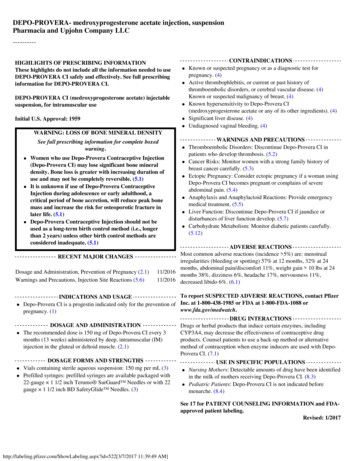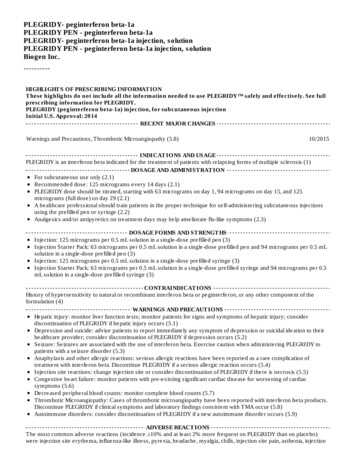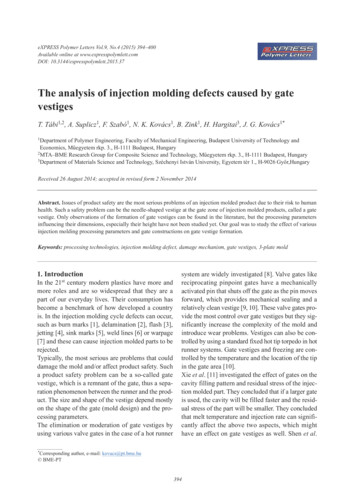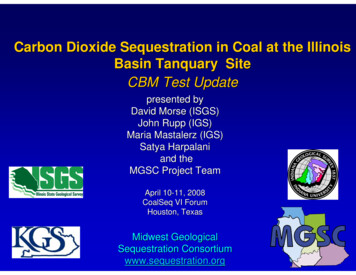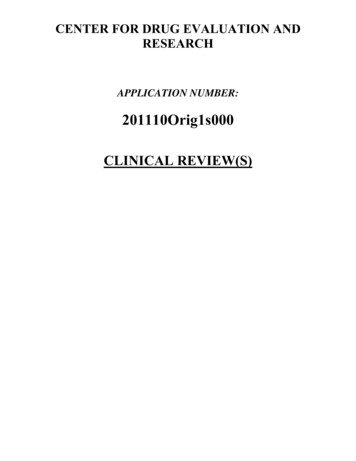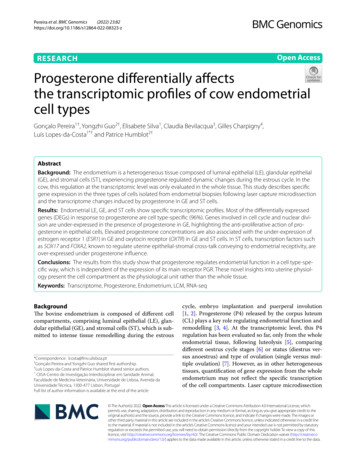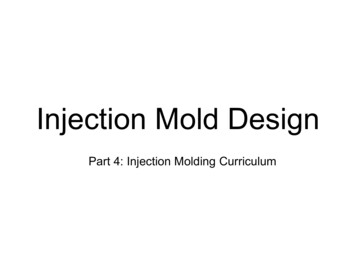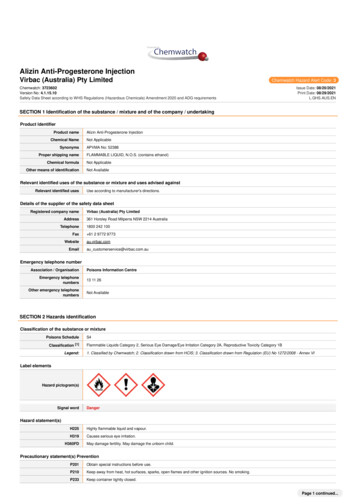
Transcription
Alizin Anti-Progesterone InjectionVirbac (Australia) Pty LimitedChemwatch Hazard Alert Code: 3Chemwatch: 3723602Version No: 4.1.15.10Safety Data Sheet according to WHS Regulations (Hazardous Chemicals) Amendment 2020 and ADG requirementsIssue Date: 08/20/2021Print Date: 08/29/2021L.GHS.AUS.ENSECTION 1 Identification of the substance / mixture and of the company / undertakingProduct IdentifierProduct nameChemical NameSynonymsProper shipping nameChemical formulaOther means of identificationAlizin Anti-Progesterone InjectionNot ApplicableAPVMA No: 52388FLAMMABLE LIQUID, N.O.S. (contains ethanol)Not ApplicableNot AvailableRelevant identified uses of the substance or mixture and uses advised againstRelevant identified usesUse according to manufacturer's directions.Details of the supplier of the safety data sheetRegistered company nameAddressTelephoneFaxWebsiteEmailVirbac (Australia) Pty Limited361 Horsley Road Milperra NSW 2214 Australia1800 242 100 61 2 9772 9773au.virbac.comau customerservice@virbac.com.auEmergency telephone numberAssociation / OrganisationEmergency telephonenumbersOther emergency telephonenumbersPoisons Information Centre13 11 26Not AvailableSECTION 2 Hazards identificationClassification of the substance or mixturePoisons ScheduleClassification [1]Legend:S4Flammable Liquids Category 2, Serious Eye Damage/Eye Irritation Category 2A, Reproductive Toxicity Category 1B1. Classified by Chemwatch; 2. Classification drawn from HCIS; 3. Classification drawn from Regulation (EU) No 1272/2008 - Annex VILabel elementsHazard pictogram(s)Signal wordDangerHazard statement(s)H225Highly flammable liquid and vapour.H319Causes serious eye irritation.H360FDMay damage fertility. May damage the unborn child.Precautionary statement(s) PreventionP201Obtain special instructions before use.P210Keep away from heat, hot surfaces, sparks, open flames and other ignition sources. No smoking.P233Keep container tightly closed.Page 1 continued.
Chemwatch: 3723602Page 2 of 13Issue Date: 08/20/2021Version No: 4.1.15.10Alizin Anti-Progesterone InjectionPrint Date: 08/29/2021P280Wear protective gloves, protective clothing, eye protection and face protection.P240Ground and bond container and receiving equipment.P241Use explosion-proof electrical/ventilating/lighting/intrinsically safe equipment.P242Use non-sparking tools.P243Take action to prevent static discharges.P264Wash all exposed external body areas thoroughly after handling.Precautionary statement(s) ResponseP308 P313IF exposed or concerned: Get medical advice/ attention.P370 P378In case of fire: Use alcohol resistant foam or normal protein foam to extinguish.P305 P351 P338P337 P313P303 P361 P353IF IN EYES: Rinse cautiously with water for several minutes. Remove contact lenses, if present and easy to do. Continue rinsing.If eye irritation persists: Get medical advice/attention.IF ON SKIN (or hair): Take off immediately all contaminated clothing. Rinse skin with water [or shower].Precautionary statement(s) StorageP403 P235P405Store in a well-ventilated place. Keep cool.Store locked up.Precautionary statement(s) DisposalP501Dispose of contents/container to authorised hazardous or special waste collection point in accordance with any local regulation.SECTION 3 Composition / information on ingredientsSubstancesSee section below for composition of MixturesMixturesCAS 10ethanolNot Available 60Ingredients determined not to be hazardousLegend:1. Classified by Chemwatch; 2. Classification drawn from HCIS; 3. Classification drawn from Regulation (EU) No 1272/2008 - Annex VI; 4.Classification drawn from C&L; * EU IOELVs availableSECTION 4 First aid measuresDescription of first aid measuresEye ContactSkin ContactIf this product comes in contact with the eyes:Wash out immediately with fresh running water.Ensure complete irrigation of the eye by keeping eyelids apart and away from eye and moving the eyelids by occasionally lifting the upperand lower lids.Seek medical attention without delay; if pain persists or recurs seek medical attention.Removal of contact lenses after an eye injury should only be undertaken by skilled personnel.If skin contact occurs:Immediately remove all contaminated clothing, including footwear.Flush skin and hair with running water (and soap if available).Seek medical attention in event of irritation.InhalationIf fumes, aerosols or combustion products are inhaled remove from contaminated area.Other measures are usually unnecessary.IngestionIf swallowed do NOT induce vomiting.If vomiting occurs, lean patient forward or place on left side (head-down position, if possible) to maintain open airway and prevent aspiration.Observe the patient carefully.Never give liquid to a person showing signs of being sleepy or with reduced awareness; i.e. becoming unconscious.Give water to rinse out mouth, then provide liquid slowly and as much as casualty can comfortably drink.Seek medical advice.Indication of any immediate medical attention and special treatment neededTreat symptomatically.SECTION 5 Firefighting measuresExtinguishing mediaWater spray or fog.Alcohol stable foam.Dry chemical powder.Carbon dioxide.Special hazards arising from the substrate or mixtureFire IncompatibilityAvoid contamination with oxidising agents i.e. nitrates, oxidising acids, chlorine bleaches, pool chlorine etc. as ignition may resultContinued.
Chemwatch: 3723602Page 3 of 13Issue Date: 08/20/2021Version No: 4.1.15.10Alizin Anti-Progesterone InjectionPrint Date: 08/29/2021Advice for firefightersFire FightingFire/Explosion HazardHAZCHEMAlert Fire Brigade and tell them location and nature of hazard.May be violently or explosively reactive.Wear breathing apparatus plus protective gloves in the event of a fire.Prevent, by any means available, spillage from entering drains or water course.Consider evacuation (or protect in place).Fight fire from a safe distance, with adequate cover.If safe, switch off electrical equipment until vapour fire hazard removed.Use water delivered as a fine spray to control the fire and cool adjacent area.Avoid spraying water onto liquid pools.Do not approach containers suspected to be hot.Cool fire exposed containers with water spray from a protected location.If safe to do so, remove containers from path of fire.Liquid and vapour are highly flammable.Severe fire hazard when exposed to heat, flame and/or oxidisers.Vapour may travel a considerable distance to source of ignition.Heating may cause expansion or decomposition leading to violent rupture of containers.On combustion, may emit toxic fumes of carbon monoxide (CO).Combustion products include:carbon dioxide (CO2)acroleinother pyrolysis products typical of burning organic material.CARE: Water in contact with hot liquid may cause foaming and a steam explosion with wide scattering of hot oil and possible severe burns.Foaming may cause overflow of containers and may result in possible fire. 3YESECTION 6 Accidental release measuresPersonal precautions, protective equipment and emergency proceduresSee section 8Environmental precautionsSee section 12Methods and material for containment and cleaning upMinor SpillsRemove all ignition sources.Clean up all spills immediately.Avoid breathing vapours and contact with skin and eyes.Control personal contact with the substance, by using protective equipment.Contain and absorb small quantities with vermiculite or other absorbent material.Wipe up.Collect residues in a flammable waste container.Slippery when spilt.Major SpillsCARE: Absorbent materials wetted with occluded oil must be moistened with water as they may auto-oxidize, become self heating and ignite.Some oils slowly oxidise when spread in a film and oil on cloths, mops, absorbents may autoxidise and generate heat, smoulder, ignite and burn.In the workplace oily rags should be collected and immersed in water.Slippery when spilt.Clear area of personnel and move upwind.Alert Fire Brigade and tell them location and nature of hazard.May be violently or explosively reactive.Wear breathing apparatus plus protective gloves.Prevent, by any means available, spillage from entering drains or water course.Consider evacuation (or protect in place).No smoking, naked lights or ignition sources.Increase ventilation.Stop leak if safe to do so.Water spray or fog may be used to disperse /absorb vapour.Contain spill with sand, earth or vermiculite.Use only spark-free shovels and explosion proof equipment.Collect recoverable product into labelled containers for recycling.Absorb remaining product with sand, earth or vermiculite.Collect solid residues and seal in labelled drums for disposal.Wash area and prevent runoff into drains.If contamination of drains or waterways occurs, advise emergency services.Personal Protective Equipment advice is contained in Section 8 of the SDS.SECTION 7 Handling and storagePrecautions for safe handlingSafe handlingAvoid all personal contact, including inhalation.Wear protective clothing when risk of exposure occurs.Use in a well-ventilated area.Prevent concentration in hollows and sumps.DO NOT enter confined spaces until atmosphere has been checked.Avoid smoking, naked lights, heat or ignition sources.When handling, DO NOT eat, drink or smoke.Vapour may ignite on pumping or pouring due to static electricity.DO NOT use plastic buckets.Earth and secure metal containers when dispensing or pouring product.Use spark-free tools when handling.Continued.
Chemwatch: 3723602Page 4 of 13Issue Date: 08/20/2021Version No: 4.1.15.10Alizin Anti-Progesterone InjectionPrint Date: 08/29/2021Avoid contact with incompatible materials.Keep containers securely sealed.Avoid physical damage to containers.Always wash hands with soap and water after handling.Work clothes should be laundered separately.Use good occupational work practice.Observe manufacturer's storage and handling recommendations contained within this SDS.Atmosphere should be regularly checked against established exposure standards to ensure safe working conditions.Other informationConsider storage under inert gas.Store in original containers in approved flame-proof area.No smoking, naked lights, heat or ignition sources.DO NOT store in pits, depressions, basements or areas where vapours may be trapped.Keep containers securely sealed.Store away from incompatible materials in a cool, dry well ventilated area.Protect containers against physical damage and check regularly for leaks.Observe manufacturer's storage and handling recommendations contained within this SDS.Conditions for safe storage, including any incompatibilitiesPacking as supplied by manufacturer.Plastic containers may only be used if approved for flammable liquid.Check that containers are clearly labelled and free from leaks.Suitable containerStorage incompatibilityAvoid oxidising agents, acids, acid chlorides, acid anhydrides, chloroformates.·The interaction of alkenes and alkynes with nitrogen oxides and oxygen may produce explosive addition products; these may form at verylow temperatures and explode on heating to higher temperatures (the addition products from 1,3-butadiene and cyclopentadiene form rapidly at-150 C and ignite or explode on warming to -35 to -15 C). These derivatives ("pseudo- nitrosites") were formerly used to characterise terpenehydrocarbons.·Exposure to air must be kept to a minimum so as to limit the build-up of peroxides which will concentrate in bottoms if the product isdistilled. The product must not be distilled to dryness if the peroxide concentration is substantially above 10 ppm (as active oxygen) sinceexplosive decomposition may occur. Distillate must be immediately inhibited to prevent peroxide formation. The effectiveness of the antioxidant islimited once the peroxide levels exceed 10 ppm as active oxygen. Addition of more inhibitor at this point is generally ineffective. Prior todistillation it is recommended that the product should be washed with aqueous ferrous ammonium sulfate to destroy peroxides; the washedproduct should be immediately re-inhibited.·A range of exothermic decomposition energies for double bonds is given as 40-90 kJ/mol. The relationship between energy ofdecomposition and processing hazards has been the subject of discussion; it is suggested that values of energy released per unit of mass, ratherthan on a molar basis (J/g) be used in the assessment. For example, in "open vessel processes" (with man-hole size openings, in an industrialsetting), substances with exothermic decomposition energies below 500 J/g are unlikely to present a danger, whilst those in "closed vesselprocesses" (opening is a safety valve or bursting disk) present some danger where the decomposition energy exceeds 150 J/g.BRETHERICK: Handbook of Reactive Chemical Hazards, 4th Edition·The reaction of ozone with alkenes is believed to proceed via the formation of a vibrationally excited Primary Ozonide (POZ) which fallsapart to give a vibrationally excited Criegee Intermediate (CI) The CI can decompose to give OH radicals, or be stabilised. This may be ofrelevance in atmospheric chemistry.·Violent explosions at low temperatures in ammonia synthesis gas units have been traced to the addition products of dienes and nitrogendioxideHAZARD:Although anti-oxidants may be present, in the original formulation, these may deplete over time as they come into contact with air.Rags wet / soaked with unsaturated hydrocarbons / drying oils may auto-oxidise; generate heat and, in-time, smoulder and ignite. This isespecially the case where oil-soaked materials are folded, bunched, compressed, or piled together - this allows the heat to accumulate oreven accelerate the reactionOily cleaning rags should be collected regularly and immersed in water, or spread to dry in safe-place away from direct sunlight.or stored,immersed, in solvents in suitably closed containers.·Materials soaked with plant/ vegetable derived (and rarely, animal) oils may undergo spontaneous combustion·The more unsaturated is the fatty acid component, the more susceptible is the oil to oxidation and spontaneous combustion.·Many vegetable and animal oils absorb oxygen from the air to form oxidation products. This oxidation process produces heat and theresultant increase in temperature accelerates the oxidation process.·Drying oils such as linseed, tung, poppy and sunflower oils and semi-drying oils such as soya bean, tall oil, corn, cotton and castor oils allabsorb oxygen readily and thus experience the self-heating process.·Cotton fibres are readily ignited and if contaminated with an oxidisable oil, may ignite unless heat can be dissipated·Vegetable oils and some animal fats undergo undesirable deterioration reactions in the presence of oxygen from the air becoming rancidaccompanying off-flavours and smells.The mechanism of autoxidation of vegetable oils is classically regarded as following a number of stages being:·a usually slow initiation phase·a usually rapid propagation·and a termination phaseThe initiation phase involves the formation of a free radical from a triglyceride molecule in the fat: this may be promoted by the presence of heavymetals in the oil, or by heat or light. The next stage is the reaction of the triglyceride free radical with oxygen to produce a peroxide free radical,which can react with another triglyceride to produce a hydroperoxide and another triglyceride free radical. Steps 2 and 3 can repeat in a chainreaction until two peroxy free radicals collide and neutralise each other.Some drying oils produce cyclic peroxides instead of hydroperoxides.Autooxidation may also occur in saturated fatty acids and their esters. Monohydroperoxides are formed. Although all carbon atoms are subject tooxidation, preferential oxidation appears to occur towards the centre of the molecule.Autoxidation is assisted by higher ambient temperatures (the rate doubling for every ten degrees Centigrade rise) and by the presence of heavymetal ions, especially copper. The degree of unsaturation of the oil is also relevant to shelf-life; oils with a high linolenic fatty acid content (3double bonds) being more prone that those with a higher saturated fatty acid content. Autoxidation can be minimized by the presence ofanti-oxidants, which can act as free-radical inhibitors. Vegetable oils should therefore be stored in a cool place away from heat and light, andshould only come into contact with inert (glass of stainless steel) containers which will not leach heavy metals. Blanketing under nitrogen shouldbe considered in bulk storages.SECTION 8 Exposure controls / personal protectionControl parametersOccupational Exposure Limits (OEL)INGREDIENT DATAContinued.
Chemwatch: 3723602Page 5 of 13Issue Date: 08/20/2021Version No: 4.1.15.10Alizin Anti-Progesterone InjectionPrint Date: 08/29/2021SourceIngredientMaterial nameTWASTELPeakNotesAustralia Exposure StandardsethanolEthyl alcohol1000 ppm / 1880 mg/m3Not AvailableNot AvailableNot AvailableEmergency LimitsIngredientTEEL-1TEEL-2TEEL-3ethanolNot AvailableNot Available15000* ppmIngredientOriginal IDLHRevised IDLHaglepristoneNot AvailableNot Availableethanol3,300 ppmNot AvailableOccupational Exposure BandingIngredientOccupational Exposure Band RatingOccupational Exposure Band LimitaglepristoneC 1 to 10 parts per million (ppm)Notes:Occupational exposure banding is a process of assigning chemicals into specific categories or bands based on a chemical's potency and theadverse health outcomes associated with exposure. The output of this process is an occupational exposure band (OEB), which corresponds to arange of exposure concentrations that are expected to protect worker health.MATERIAL DATAExposure controlsCare: Atmospheres in bulk storages and even apparently empty tanks may be hazardous by oxygen depletion. Atmosphere must be checkedbefore entry.Requirements of State Authorities concerning conditions for tank entry must be met. Particularly with regard to training of crews for tank entry;work permits; sampling of atmosphere; provision of rescue harness and protective gear as neededEngineering controls are used to remove a hazard or place a barrier between the worker and the hazard. Well-designed engineering controls canbe highly effective in protecting workers and will typically be independent of worker interactions to provide this high level of protection.The basic types of engineering controls are:Process controls which involve changing the way a job activity or process is done to reduce the risk.Enclosure and/or isolation of emission source which keeps a selected hazard "physically" away from the worker and ventilation that strategically"adds" and "removes" air in the work environment. Ventilation can remove or dilute an air contaminant if designed properly. The design of aventilation system must match the particular process and chemical or contaminant in use.Employers may need to use multiple types of controls to prevent employee overexposure.For flammable liquids and flammable gases, local exhaust ventilation or a process enclosure ventilation system may be required. Ventilationequipment should be explosion-resistant.Air contaminants generated in the workplace possess varying "escape" velocities which, in turn, determine the "capture velocities" of freshcirculating air required to effectively remove the contaminant.Type of Contaminant:Air Speed:solvent, vapours, degreasing etc., evaporating from tank (in still air).0.25-0.5 m/s(50-100f/min.)aerosols, fumes from pouring operations, intermittent container filling, low speed conveyer transfers, welding, spray drift,plating acid fumes, pickling (released at low velocity into zone of active generation)0.5-1 m/s(100-200f/min.)direct spray, spray painting in shallow booths, drum filling, conveyer loading, crusher dusts, gas discharge (activegeneration into zone of rapid air motion)1-2.5 m/s(200-500f/min.)Appropriate engineeringcontrolsWithin each range the appropriate value depends on:Lower end of the rangeUpper end of the range1: Room air currents minimal or favourable to capture1: Disturbing room air currents2: Contaminants of low toxicity or of nuisance value only.2: Contaminants of high toxicity3: Intermittent, low production.3: High production, heavy use4: Large hood or large air mass in motion4: Small hood-local control onlySimple theory shows that air velocity falls rapidly with distance away from the opening of a simple extraction pipe. Velocity generally decreaseswith the square of distance from the extraction point (in simple cases). Therefore the air speed at the extraction point should be adjusted,accordingly, after reference to distance from the contaminating source. The air velocity at the extraction fan, for example, should be a minimum of1-2 m/s (200-400 f/min.) for extraction of solvents generated in a tank 2 meters distant from the extraction point. Other mechanicalconsiderations, producing performance deficits within the extraction apparatus, make it essential that theoretical air velocities are multiplied byfactors of 10 or more when extraction systems are installed or used.Personal protectionEye and face protectionSkin protectionSafety glasses with side shields.Chemical goggles.Contact lenses may pose a special hazard; soft contact lenses may absorb and concentrate irritants. A written policy document, describingthe wearing of lenses or restrictions on use, should be created for each workplace or task. This should include a review of lens absorptionand adsorption for the class of chemicals in use and an account of injury experience. Medical and first-aid personnel should be trained intheir removal and suitable equipment should be readily available. In the event of chemical exposure, begin eye irrigation immediately andremove contact lens as soon as practicable. Lens should be removed at the first signs of eye redness or irritation - lens should be removed ina clean environment only after workers have washed hands thoroughly. [CDC NIOSH Current Intelligence Bulletin 59], [AS/NZS 1336 ornational equivalent]See Hand protection belowContinued.
Chemwatch: 3723602Page 6 of 13Issue Date: 08/20/2021Version No: 4.1.15.10Alizin Anti-Progesterone InjectionPrint Date: 08/29/2021Hands/feet protectionBody protectionOther protectionWear chemical protective gloves, e.g. PVC.Wear safety footwear or safety gumboots, e.g. RubberThe selection of suitable gloves does not only depend on the material, but also on further marks of quality which vary from manufacturer tomanufacturer. Where the chemical is a preparation of several substances, the resistance of the glove material can not be calculated in advanceand has therefore to be checked prior to the application.The exact break through time for substances has to be obtained from the manufacturer of the protective gloves and has to be observed whenmaking a final choice.Personal hygiene is a key element of effective hand care. Gloves must only be worn on clean hands. After using gloves, hands should bewashed and dried thoroughly. Application of a non-perfumed moisturiser is recommended.Suitability and durability of glove type is dependent on usage. Important factors in the selection of gloves include:·frequency and duration of contact,·chemical resistance of glove material,·glove thickness and·dexteritySelect gloves tested to a relevant standard (e.g. Europe EN 374, US F739, AS/NZS 2161.1 or national equivalent).·When prolonged or frequently repeated contact may occur, a glove with a protection class of 5 or higher (breakthrough time greater than240 minutes according to EN 374, AS/NZS 2161.10.1 or national equivalent) is recommended.·When only brief contact is expected, a glove with a protection class of 3 or higher (breakthrough time greater than 60 minutes according toEN 374, AS/NZS 2161.10.1 or national equivalent) is recommended.·Some glove polymer types are less affected by movement and this should be taken into account when considering gloves for long-termuse.·Contaminated gloves should be replaced.As defined in ASTM F-739-96 in any application, gloves are rated as:·Excellent when breakthrough time 480 min·Good when breakthrough time 20 min·Fair when breakthrough time 20 min·Poor when glove material degradesFor general applications, gloves with a thickness typically greater than 0.35 mm, are recommended.It should be emphasised that glove thickness is not necessarily a good predictor of glove resistance to a specific chemical, as the permeationefficiency of the glove will be dependent on the exact composition of the glove material. Therefore, glove selection should also be based onconsideration of the task requirements and knowledge of breakthrough times.Glove thickness may also vary depending on the glove manufacturer, the glove type and the glove model. Therefore, the manufacturers’technical data should always be taken into account to ensure selection of the most appropriate glove for the task.Note: Depending on the activity being conducted, gloves of varying thickness may be required for specific tasks. For example:·Thinner gloves (down to 0.1 mm or less) may be required where a high degree of manual dexterity is needed. However, these gloves areonly likely to give short duration protection and would normally be just for single use applications, then disposed of.·Thicker gloves (up to 3 mm or more) may be required where there is a mechanical (as well as a chemical) risk i.e. where there is abrasionor puncture potentialGloves must only be worn on clean hands. After using gloves, hands should be washed and dried thoroughly. Application of a non-perfumedmoisturiser is recommended.Neoprene rubber glovesSee Other protection belowOveralls.PVC Apron.PVC protective suit may be required if exposure severe.Eyewash unit.Ensure there is ready access to a safety shower.Some plastic personal protective equipment (PPE) (e.g. gloves, aprons, overshoes) are not recommended as they may produce staticelectricity.For large scale or continuous use wear tight-weave non-static clothing (no metallic fasteners, cuffs or pockets).Non sparking safety or conductive footwear should be considered. Conductive footwear describes a boot or shoe with a sole made from aconductive compound chemically bound to the bottom components, for permanent control to electrically ground the foot an shall dissipatestatic electricity from the body to reduce the possibility of ignition of volatile compounds. Electrical resistance must range between 0 to500,000 ohms. Conductive shoes should be stored in lockers close to the room in which they are worn. Personnel who have been issuedconductive footwear should not wear them from their place of work to their homes and return.Recommended material(s)Respiratory protectionGLOVE SELECTION INDEXGlove selection is based on a modified presentation of the:"Forsberg Clothing Performance Index".The effect(s) of the following substance(s) are taken into account in the computergenerated selection:Alizin Anti-Progesterone InjectionType A-P Filter of sufficient capacity. (AS/NZS 1716 & 1715, EN 143:2000 & 149:2001,ANSI Z88 or national equivalent)Where the concentration of gas/particulates in the breathing zone, approaches orexceeds the "Exposure Standard" (or ES), respiratory protection is required.Degree of protection varies with both face-piece and Class of filter; the nature ofprotection varies with Type of filter.MaterialCPIBUTYLARequired MinimumProtection d AirRespiratorNEOPRENEAup to 5 x ESAir-line*A-2 P2A-PAPR-2 P2 NITRILEAup to 10 x ES-A-3 P2-NITRILE PVCA10 x ES-Air-line**-PE/EVAL/PEAPVCBNATURAL RUBBERCNATURAL NEOPRENEC* CPI - Chemwatch Performance IndexA: Best SelectionB: Satisfactory; may degrade after 4 hours continuous immersionC: Poor to Dangerous Choice for other than short term immersionNOTE: As a series of factors will influence the actual performance of the glove, a finalselection must be based on detailed observation. * Where the glove is to be used on a short term, casual or infrequent basis, factors suchas "feel" or convenience (e.g. disposability), may dictate a choice of gloves which might* - Continuous Flow; ** - Continuous-flow or positive pressure demand - Full-faceA(All classes) Organic vapours, B AUS or B1 Acid gasses, B2 Acid gas orhydrogen cyanide(HCN), B3 Acid gas or hydrogen cyanide(HCN), E Sulfurdioxide(SO2), G Agricultural chemicals, K Ammonia(NH3), Hg Mercury, NO Oxides of nitrogen, MB Methyl bromide, AX Low boiling point organiccompounds(below 65 degC)Cartridge respirators should never be used for emergency ingress or in areas ofunknown vapour concentrations or oxygen content.The wearer must be warned to leave the contaminated area immediately ondetecting any odours through the respirator. The odour may indicate that the mask isnot functioning properly, that the vapour concentration is too high, or that the mask isnot properly fitted. Because of these limitations, only restricted use of cartridgerespirators is considered appropriate.Continued.
Chemwatch: 3723602Page 7 of 13Issue Date: 08/20/2021Version No: 4.1.15.10Alizin Anti-Progesterone InjectionPrint Date: 08/29/2021otherwise be unsuitable following long-term or frequent use. A qualified practitionershould be consulted.Cartridge performance is affected by humidity. Cartridges should be changed after 2hr of continuous use unless it is determined that the humidity is less than 75%, inwhich case, cartridges can be used for 4 hr. Used cartridges should be discardeddaily, regardless of the length of time usedSECTION 9 Physical and chemical propertiesInformation on basic physical and chemical propertiesAppearancePhysical stateClear highly flammable yellow oily liquid; mixes with water.LiquidRelative density (Water 1)Not AvailableNot AvailableOdourNot AvailablePartition coefficient n-octanol/ waterOdour thresholdNot AvailableAuto-ignition temperature ( C)Not AvailablepH (as supplied)N
BRETHERICK: Handbook of Reactive Chemical Hazards, 4th Edition · The reaction of ozone with alkenes is believed to proceed via the formation of a vibrationally excited Primary Ozonide (POZ) which falls HAZARD : Chemwatch: 3723602 Version No: 4.1.15.10 Alizin Anti-Progesterone Injection



